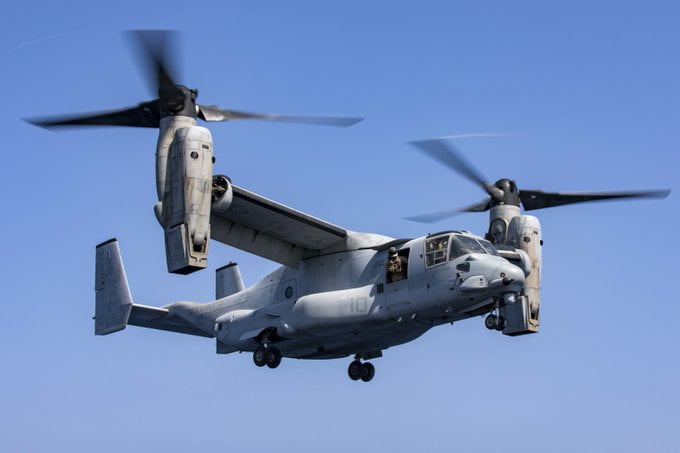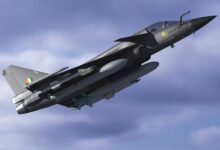Five Years After The Tragic Incident On The USS Green Bay, A Terrifying Video Of A “US Helicopter Crash” Is Posted Online

- The left proprotor blades struck the flight deck and a nearby helicopter, crushing the cockpit and shattering the pilot's hip and leg inside.
- The project's high cost has been the primary source of criticism for this aircraft development.
The US warship was at the time engaged in operations close to Queensland, Australia. As it approaches the flight deck of the amphibious transport dock ship of the San Antonio class, the video appears to show the aircraft flying normally. The plane then dramatically lowers, smacking the deck with the left engine’s nacelle.
Before the clip ends, the sailor observing the landing from the vicinity of the ship’s hangar bay realises how serious the situation has become and begins running.
Due to the fact that other aircraft are frequently very near by and may be carrying fuel or armaments, these crashes can be extremely perilous for amphibious warships.
If the aircraft’s rotor blades strike the deck and break into big pieces of highly fast shrapnel that have the potential to split an object or an aircraft in half, they could experience exceptionally severe damage.
The aforementioned Osprey was also hauling gasoline.
What Does The Investigation Report Say?
On May 21, 2018, USNI News released an article on the conclusions of the crash investigation board. According to the investigation, it was a risky but safe endeavour.
The Marine Corps found the plane’s downwash was too great and there wasn’t enough thrust to keep it hovering, but a Defense Department official told USNI News the plane might also have been overloaded.
According to the person, experts from Naval Air Systems Command have subsequently looked into the effect of downwash on a landing aircraft and the amount of power the Osprey needs to overcome it and land safely.

According to the report, changes have also been made to the weight that an Osprey may carry when it approaches a US ship at sea in order to give it the power it needs to land.
The investigative report makes it very evident that no one was to blame for the occurrence and that all three staff members passed away while performing their jobs, not as a result of malfeasance.
As a member of a three-aircraft formation, the Osprey took part in a mission that comprised a simulated embassy reinforcement, a non-combatant evacuation operation, a mass casualty scenario, and supplies moves.
The mishap Osprey flew from the amphibious assault ship USS Bonhomme Richard (LHD-6) to the shore at Raspberry Creek to insert embassy reinforcement personnel, back to the ship to refuel, to the nearby USS Ashland (LSD-48) to deliver cargo and a passenger, back to Bonhomme Richard, participated in a mass casualty drill while aboard the ship, and delivered mass casualty personnel ashore to Raspberry Creek on the day of the crash.
After returning to Bonhomme Richard with additional passengers, it made a further run to Raspberry Creek and back to the amphibious ship. It then made its final run to Raspberry Creek to pick up non-combatant evacuation personnel before travelling to Green Bay, where the fatal accident took place, according to the report.
The Osprey originally had trouble connecting to the Tactical Air Navigation signal as it approached Green Bay, but soon received instructions from the ship’s air traffic controllers.
As it got closer, the Osprey switched to the launch and landing frequency on its radio. The assessment states that the plane did land as intended in Spot 5 on Green Bay and that it did so according to the correct procedures.
By applying power with the Thrust Control Lever, the pilot “identified and attempted to rectify a 200-300 foot per minute rate of fall,” according to the report.
“The pilot and copilot – 1st Lt. Benjamin Cross, who died in the crash – could not stop the descent and took several actions, including moving the Osprey’s nacelles forward. The left nacelle struck the Green Bay flight deck, and the Osprey moved forward along the starboard side until the plane hit a steel stairway.”
The left proprotor blades struck the flight deck and a nearby helicopter, crushing the cockpit and shattering the pilot’s hip and leg inside. After that, the aircraft dropped 30 feet into the ocean, where a hole in the cockpit immediately generated a deluge. All passengers, with the exception of three, made it out of the disaster alive.
Other Crashes
The USNI News piece goes into greater depth about the incident’s resemblance to a less serious incident that occurred on board USS New Orleans in 2015, as well as the findings of the investigations and how Osprey operations were changed as a result of the crash.
Even though the Osprey has had a remarkable career following a highly tumultuous and protracted development, the tilt-rotor still has its detractors. The project’s high cost has been the primary source of criticism for this aircraft development.
The aircraft had its first flight in 1989, and since then, the project’s development expenses have risen dramatically, from a $68.7 million design contract in 1983 to $29.1 billion for research and procurement in 2009.
An earlier assessment put the average cost of an aeroplane at $83.7 million. By 2012, some estimates put the total cost at $56 billion and the price per unit at $100 million.
A Black Hawk combat helicopter type costs between $20 million to $40 million, in contrast. Recently, there were a few further occurrences involving the aircraft. Four people died in an MV-22 collision in Norway in March.
As previously reported by the EurAsian Times, a second Marine Osprey crashed in June 2022 close to El Centro, California, killing all five persons on board. One of the most useful tools in the US military’s arsenal has proven to be the aircraft.
For US military missions, the aircraft is essential, especially in the hazardous maritime area. The V-22 is proving to be very useful in all of its forms as the US military continues to concentrate on the Indo-Pacific region.







Facebook Comments